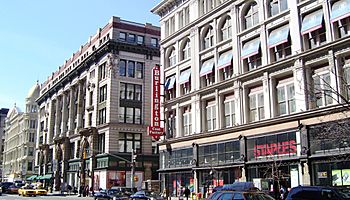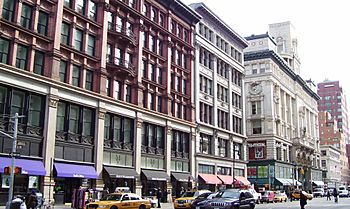Ladies' Mile Historic District facts for kids
The Ladies' Mile Historic District was a very popular shopping area in Manhattan, New York City. It was famous at the end of the 1800s. Rich people, often arriving in carriages, came here to shop.
In May 1989, the New York City Landmarks Preservation Commission officially named it a historic district. This was done to protect about 440 old buildings. The district covers 28 blocks, roughly from 15th Street to 24th Street. It stretches from Park Avenue South to west of Avenue of the Americas. Local groups worked hard to make this happen.
Most buildings in the Ladies' Mile Historic District are tall stores and loft buildings. Loft buildings are large, open spaces often used for businesses or workshops. These buildings became common after 1899. New laws made it harder to live and work in the same place without special permission. Also, worker groups (unions) wanted better working conditions. This led many people to look for separate work spaces.
Contents
History of the Ladies' Mile
How the Area Became Popular
The Ladies' Mile area first became well-known around 1860. This was when the Prince of Wales stayed at the Fifth Avenue Hotel. This hotel was at the corner of Fifth Avenue and 23rd Street. His visit showed New York's rich and famous that the neighborhood was a fancy and proper place to be.
Between the American Civil War and World War I, this district was home to many of New York's most famous stores. These included fancy department stores and shops like B. Altman, Best & Co., Arnold Constable, Bergdorf Goodman, Lord & Taylor, and Tiffany & Co..
The Ladies' Mile also had nice restaurants and bookstores. You could find offices and showrooms for piano makers, like in the Sohmer Piano Building. There were also places for shows, such as the Academy of Music. The first home of the Metropolitan Museum of Art was also here.
Famous Shoppers and Residents
All these attractions brought wealthy people and celebrities to the area. It was a safe place, which meant women could shop without a man with them. Famous people like Ethel Barrymore, Isabella Stewart Gardner, and Lillian Russell were often seen here.
Many important people also lived in the area. These included Horace Greeley, Washington Irving, Samuel F. B. Morse, Emily Post, and Edith Wharton. Members of the Roosevelt family also lived nearby.
Changes Over Time
Over time, the district became less exclusive and more commercial. Many rich residents moved to other parts of the city. The fancy department stores and shops followed them.
By the end of World War I, most buildings were used as warehouses. They also became lofts for factories and some homes. Luckily, most of the buildings were not torn down.
By the 1980s, people started fixing up these old buildings. They were turned back into large stores on the ground floor and sometimes above. So, the old shopping district is now a shopping area again. However, it attracts a different kind of shopper today. Stores in the district now include Bed, Bath & Beyond, Burlington Coat Factory, Old Navy, and Trader Joe's.
A very important building in the district is the Flatiron Building. It was designed by Daniel H. Burnham. It stands at Fifth Avenue and 23rd Street. Most of the Ladies' Mile Historic District is within the neighborhood named after this building, the Flatiron District.
Notable Buildings to See
Here are some of the important buildings in the Ladies' Mile Historic District:
- Church of the Holy Communion, 49 West 20th Street, built in 1846.
- Arnold Constable Building, 881-887 Broadway, built between 1868 and 1877.
- B. Altman Dry Goods Store, 621 6th Avenue, built around 1877.
- Gorham Manufacturing Company Building, 889-891 Broadway, built in 1884.
- Siegel-Cooper Dry Goods Store, 616-632 6th Avenue, built in 1896.
- Flatiron Building, Broadway and Fifth Avenue at East 23rd Street, built between 1902 and 1903.
- Spero Building, 19-27 West 21st Street, built between 1907 and 1908.
- Masonic Hall, 71 W 23rd Street, built around 1910.
- 9-11 East 16th Street, 9-11 East 16th Street, built between 1895 and 1896.



